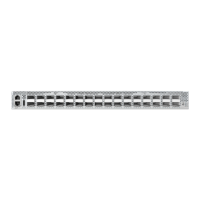C
HAPTER
1
| Introduction
Description of Software Features
– 62 –
TRAFFIC
PRIORITIZATION
This switch prioritizes each packet based on the required level of service,
using eight priority queues with strict priority, Weighted Round Robin
(WRR), or a combination of strict and weighted queuing. It uses IEEE
802.1p and 802.1Q tags to prioritize incoming traffic based on input from
the end-station application. These functions can
be used to provide
independent priorities for delay-sensitive data and best-effort data.
This switch also supports several common methods of prioritizing layer 3/4
traffic to meet application requirements. Traffic can be prioritized based on
the priority bits in the IP frame’s Type of Service (ToS) octet using DSCP, IP
Precedence, or TCP/UDP port numbers. When these services are enabled,
the priorities are mapped to a Class of Service value by the switch, and the
traffic then sent to the corresponding output queue.
QUALITY OF SERVICE Differentiated Services (DiffServ) provides policy-based management
mechanisms used for prioritizing network resources to meet the
requirements of specific traffic types on a per-hop basis. Each packet is
classified upon entry into the network based on access lists, IP Precedence
or DSCP values, or VLAN lists. Using access lists allows you select traffic
based on Layer 2, Layer 3, or Layer 4 information contained in each
packet. Based on network policies, different kinds of traffic can be marked
for different kinds of forwarding.
IP ROUTING The switch provides Layer 3 IP routing. To maintain a high rate of
throughput, the switch forwards all traffic passing within the same
segment, and routes only traffic that passes between different
subnetworks. The wire-speed routing provided by this switch lets you
easily link network segments or VLANs together without having to deal
with the bottlenecks or configuration hassles normally associated with
conventional routers.
Routing for unicast traffic is supported with static routing, Routing
Information Protocol (RIP), Open Shortest Path First (OSPF) protocol.
Static Routing – Traffic is automatically routed between any IP interfaces
configured on the ECN430-switch. Routing to statically configured hosts or
subnet addresses is provided based on next-hop entries specified in the
static routing table.
RIP – This protocol uses a distance-vector approach to routing. Routes are
determined on the basis of minimizing the distance vector, or hop count,
which serves as a rough estimate of transmission cost.
OSPF – This approach uses a link state routing protocol to generate a
shortest-path tree, then builds up its routing table based on this tree. OSPF
produces a more stable network because the participating routers act on
network changes predictably and simultaneously, converging on the best
route more quickly than RIP.

